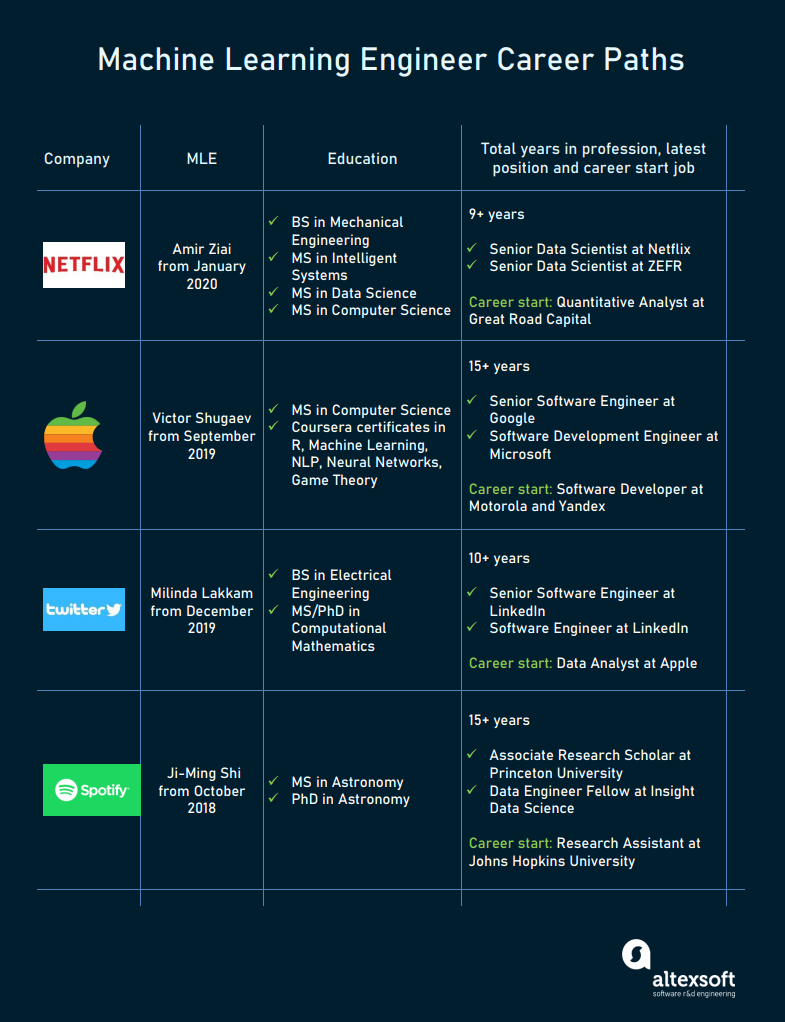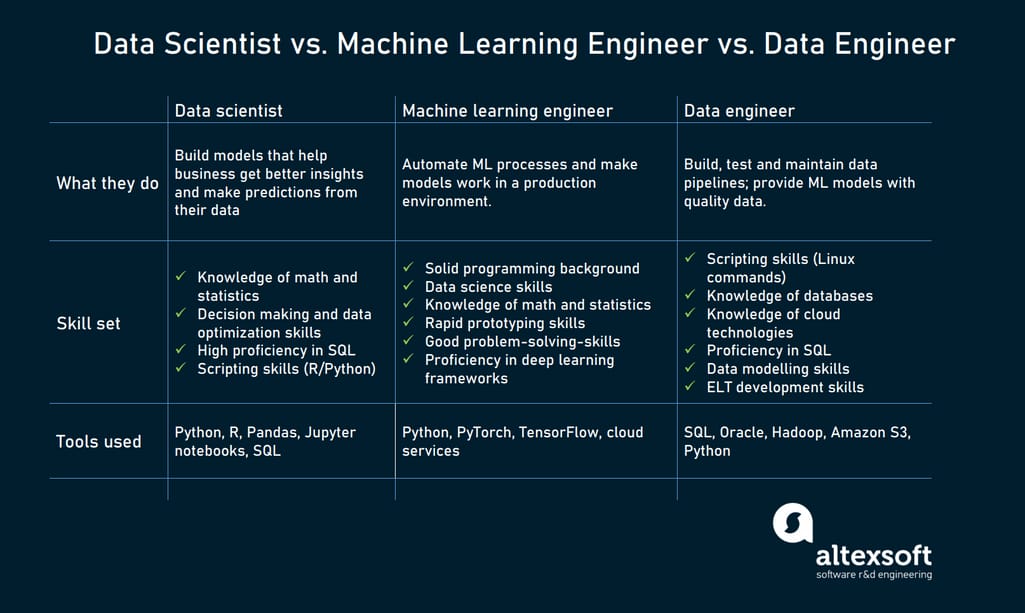All Categories
Featured
Table of Contents
- – The Ultimate Guide To Machine Learning Enginee...
- – The Only Guide to Ai Engineer Vs. Software Eng...
- – The Definitive Guide for How I’d Learn Machin...
- – Machine Learning In Production for Beginners
- – How Machine Learning Engineer Learning Path ...
- – Some Known Questions About Should I Learn Da...
You most likely know Santiago from his Twitter. On Twitter, every day, he shares a lot of practical points regarding maker learning. Alexey: Prior to we go right into our main topic of relocating from software program design to equipment knowing, maybe we can begin with your background.
I started as a software program designer. I mosted likely to college, obtained a computer technology level, and I started building software program. I believe it was 2015 when I chose to opt for a Master's in computer scientific research. At that time, I had no concept concerning equipment learning. I really did not have any kind of interest in it.
I know you have actually been utilizing the term "transitioning from software application engineering to artificial intelligence". I like the term "including in my ability the device knowing skills" a lot more since I assume if you're a software application designer, you are already supplying a lot of worth. By incorporating artificial intelligence now, you're increasing the impact that you can carry the sector.
Alexey: This comes back to one of your tweets or maybe it was from your program when you contrast 2 approaches to knowing. In this case, it was some problem from Kaggle about this Titanic dataset, and you just find out exactly how to fix this trouble using a particular tool, like decision trees from SciKit Learn.
The Ultimate Guide To Machine Learning Engineer Learning Path
You initially find out mathematics, or linear algebra, calculus. When you recognize the math, you go to maker discovering concept and you discover the theory.
If I have an electric outlet below that I need replacing, I don't intend to most likely to college, invest four years understanding the math behind power and the physics and all of that, simply to alter an electrical outlet. I would rather begin with the electrical outlet and find a YouTube video that assists me go through the trouble.
Negative example. However you understand, right? (27:22) Santiago: I truly like the concept of starting with a problem, attempting to toss out what I recognize approximately that trouble and recognize why it does not work. Get the devices that I require to fix that issue and start digging much deeper and deeper and deeper from that factor on.
That's what I generally suggest. Alexey: Possibly we can speak a little bit concerning learning resources. You discussed in Kaggle there is an introduction tutorial, where you can obtain and discover how to make decision trees. At the beginning, before we started this interview, you stated a couple of books.
The only need for that program is that you know a little of Python. If you're a programmer, that's a terrific beginning point. (38:48) Santiago: If you're not a designer, then I do have a pin on my Twitter account. If you most likely to my profile, the tweet that's mosting likely to be on the top, the one that claims "pinned tweet".
The Only Guide to Ai Engineer Vs. Software Engineer - Jellyfish

Also if you're not a designer, you can begin with Python and function your method to more machine understanding. This roadmap is concentrated on Coursera, which is a system that I really, actually like. You can examine every one of the training courses absolutely free or you can pay for the Coursera membership to obtain certificates if you wish to.
To ensure that's what I would do. Alexey: This returns to among your tweets or maybe it was from your training course when you compare 2 strategies to knowing. One technique is the trouble based strategy, which you just spoke about. You find an issue. In this instance, it was some issue from Kaggle concerning this Titanic dataset, and you simply discover how to resolve this issue utilizing a certain device, like choice trees from SciKit Learn.
You initially learn mathematics, or direct algebra, calculus. When you understand the math, you go to machine knowing theory and you find out the theory.
If I have an electric outlet here that I need replacing, I do not intend to most likely to college, spend 4 years comprehending the math behind electrical energy and the physics and all of that, simply to transform an outlet. I prefer to begin with the outlet and find a YouTube video clip that aids me go via the problem.
Santiago: I really like the concept of starting with a trouble, trying to toss out what I recognize up to that problem and comprehend why it does not function. Grab the tools that I need to solve that issue and begin digging much deeper and deeper and deeper from that point on.
That's what I normally advise. Alexey: Perhaps we can chat a little bit about finding out resources. You mentioned in Kaggle there is an intro tutorial, where you can obtain and learn how to make decision trees. At the start, prior to we began this interview, you mentioned a couple of publications as well.
The Definitive Guide for How I’d Learn Machine Learning In 2024 (If I Were Starting ...
The only demand for that course is that you know a little bit of Python. If you're a designer, that's a wonderful starting point. (38:48) Santiago: If you're not a programmer, after that I do have a pin on my Twitter account. If you most likely to my profile, the tweet that's mosting likely to get on the top, the one that says "pinned tweet".
Also if you're not a designer, you can start with Python and work your method to more equipment discovering. This roadmap is concentrated on Coursera, which is a system that I actually, really like. You can examine all of the training courses free of cost or you can spend for the Coursera registration to obtain certifications if you wish to.
Machine Learning In Production for Beginners
That's what I would certainly do. Alexey: This comes back to among your tweets or possibly it was from your program when you compare 2 techniques to learning. One approach is the problem based strategy, which you simply discussed. You locate an issue. In this instance, it was some problem from Kaggle concerning this Titanic dataset, and you just discover just how to fix this problem utilizing a details device, like decision trees from SciKit Learn.

You initially find out mathematics, or straight algebra, calculus. When you know the math, you go to equipment discovering concept and you learn the theory.
If I have an electric outlet below that I need replacing, I do not wish to most likely to university, invest four years understanding the mathematics behind electrical power and the physics and all of that, simply to change an electrical outlet. I would rather begin with the electrical outlet and locate a YouTube video clip that assists me undergo the issue.
Santiago: I really like the idea of starting with an issue, trying to throw out what I recognize up to that issue and understand why it does not function. Get the devices that I need to address that problem and begin digging deeper and much deeper and much deeper from that point on.
Alexey: Possibly we can talk a bit concerning learning resources. You stated in Kaggle there is an intro tutorial, where you can get and learn how to make decision trees.
How Machine Learning Engineer Learning Path can Save You Time, Stress, and Money.
The only need for that program is that you recognize a bit of Python. If you're a developer, that's a great beginning point. (38:48) Santiago: If you're not a designer, then I do have a pin on my Twitter account. If you most likely to my profile, the tweet that's mosting likely to get on the top, the one that says "pinned tweet".
Also if you're not a programmer, you can start with Python and work your way to more equipment understanding. This roadmap is concentrated on Coursera, which is a platform that I truly, actually like. You can investigate all of the courses for totally free or you can pay for the Coursera subscription to obtain certificates if you wish to.
To make sure that's what I would certainly do. Alexey: This returns to one of your tweets or perhaps it was from your course when you compare two techniques to knowing. One strategy is the problem based technique, which you simply spoke about. You find an issue. In this situation, it was some issue from Kaggle about this Titanic dataset, and you just find out just how to solve this issue making use of a details tool, like choice trees from SciKit Learn.
You initially discover mathematics, or straight algebra, calculus. When you know the math, you go to equipment understanding theory and you discover the concept. Four years later, you finally come to applications, "Okay, just how do I use all these 4 years of math to resolve this Titanic problem?" Right? In the previous, you kind of save on your own some time, I think.
Some Known Questions About Should I Learn Data Science As A Software Engineer?.
If I have an electrical outlet here that I require replacing, I do not intend to most likely to college, spend four years comprehending the math behind electrical power and the physics and all of that, just to alter an electrical outlet. I prefer to begin with the electrical outlet and discover a YouTube video clip that helps me undergo the issue.
Santiago: I actually like the concept of starting with a problem, attempting to toss out what I know up to that issue and recognize why it does not function. Order the devices that I require to fix that problem and start excavating much deeper and much deeper and deeper from that factor on.

Alexey: Perhaps we can speak a bit about learning resources. You stated in Kaggle there is an intro tutorial, where you can get and find out exactly how to make choice trees.
The only demand for that course is that you understand a bit of Python. If you're a developer, that's an excellent beginning factor. (38:48) Santiago: If you're not a designer, then I do have a pin on my Twitter account. If you most likely to my account, the tweet that's going to get on the top, the one that claims "pinned tweet".
Even if you're not a designer, you can start with Python and work your method to even more machine learning. This roadmap is focused on Coursera, which is a platform that I really, actually like. You can investigate all of the courses for complimentary or you can pay for the Coursera membership to get certificates if you wish to.
Table of Contents
- – The Ultimate Guide To Machine Learning Enginee...
- – The Only Guide to Ai Engineer Vs. Software Eng...
- – The Definitive Guide for How I’d Learn Machin...
- – Machine Learning In Production for Beginners
- – How Machine Learning Engineer Learning Path ...
- – Some Known Questions About Should I Learn Da...
Latest Posts
What Are Faang Recruiters Looking For In Software Engineers?
The Complete Software Engineer Interview Cheat Sheet – Tips & Strategies
How To Create A Study Plan For A Software Engineering Technical Interview
More
Latest Posts
What Are Faang Recruiters Looking For In Software Engineers?
The Complete Software Engineer Interview Cheat Sheet – Tips & Strategies
How To Create A Study Plan For A Software Engineering Technical Interview